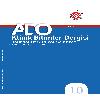The Comparison of Yield and Fiber Quality of Cotton (Gossypium hirsutum L.) Progeny Rows Under Full and Deficit Irrigation
Bu çalışma F5 generasyonunda tek bitki döl sıralarının tam ve kısıtlı sulama koşullarında verim, verimkomponentleri ve lif kalite özelliklerinin belirlenmesi amacıyla yapılmıştır. Deneme Adnan MenderesÜniversitesi Ziraat Fakültesi uygulama alanında tam (% 00) ve kısıtlı (%50) sulama koşullarında yürütülmüştür.Tam sulama denemesinde 124 tek bitki, kısıtlı sulama da 72 tek bitki, BA 308, Gloria, Claudia, Carmen ve Elsakontrol çeşitleri ile birlikte Augmented deneme desenine göre, tekerrürlü olarak sıra arası 70 cm, sıra üzeri 20cm, sıra uzunluğu 12 olacak şekilde ekilmiştir. Tam (%100) sulama koşullarında incelenen tüm özelliklerbakımından, kısıtlı sulama (%50) koşullarında ise bitkide koza sayısı ve kütlü pamuk verimi yönünden genotipikfarklılığın önemli olduğu saptanmıştır. Bu çalışma sonucunda tek bitki döl sıraları; verim, verim komponentlerive lifkalite özellikleri bakımından birlikte değerlendirildiğinde, tam sulama koşullarında, Carmen Nazilli-503 (H: ll), Nazilli-503 Şahin-2000 (H: 109), Carmen Nazilli-503 (H: 119), ST--373 DPL-90 (H: 122), kısıtlı sulama koşullarında ise Carmen Nazilli-503 (H: 20), Nazilli-503 Tamcot-22 (H: 61), Carmen DPL-9O (H: 75) tek bitki döl sıraları ümit verici döl sıraları olarak saptanmıştır.
TAM ve KISITLI SU_LAMA KOŞULLARINDA PAMUK_(G_ossypium hirsutum L.) DÖL SIRALARININ VERIM ve LIF KALITE OZELLIKLERININ KARŞILAŞTIRILMASf
This study was conducted to determine the yield, yield components and fiber quality parameters in single plantprogeny rows at generation under the full and deficit irrigation conditions. The experiment was conducted atAdnan Menderes University, Agriculture Faculty in full and deficit conditions. ln the full irrigation experiment,124 single plants, and in the experiment of deficit irrigation 72 single plants were planted with control cottonvarieties including BA 308, Gloria, Claudia, Carmen and Elsa. Augmented experiment design was used withreplications by 70 cm of row spacing and 12 of row length. Under full irrigation genotypic variation was foundto be significant for all investigated parameters and under deficit irrigation significant variation was detected forboll number per plant and seed cotton yield. The result of the study showed that in generation; Carmen Nazilli-503 (H: 11), Nazilli-503 Şahin-2000(H: 109), Carmenx Nazilli-503(H: 119), ST--373 DPL-90(H: 122) single progeny lines for full irrigation, and Carmen Nazilli-503(H: 20), Nazilli-503 Tamcot-22(H: 61), Carmen DPL-90(H: 75) single progeny lines for deficit irrigation have been detected as promising hybrids based on yield, yield components, and fiber quality parameters.
___
- Asadi R, Kohi N, Tavassoli (2011) Effect of irrigation regime and method of strip irrigation system on yield, yield components and water use efficiency of cotton under drought stress conditions of Orzouiyeh region of Kerman province in Iran. Scientific Research and Essays, Vol. 6(27), pp. 5812-5819.
- Basal 1-1, Dagdelen N, Unay A, Yilmaz (2009) Effects of deficit drip irrigation ratios on cotton (Gossypium hirsutum L.) yield and fiber quality. Agron. Crop Sci., 195: 19-29.
- Ceccarelli (1996) Positive interpretation of genotype by environment interaction in relation to sustainability and biodiversity. p. 467486. Plant adaptation and crop improvement. Editör: Cooper M.,1-1ammers G.L. Wallingford UK.
- Karademir C, Karademir E, Gençer (201 1) Yield and fiber quality of and F2 generations of cotton (Gossypium hirsutum L.) under drought stress conditions, Bulgarian ournal ofAgricultural Science, 17(6): 795-805 pp.
- Krieg DR (1997) Genetic and environmental factors affecting productivity of cotton. Proc. BeltwideCottonProd. Res. Conf. p: 1347.
- Lokhande S, Reddy (2014) Reproductive and Fiber Quality Responses of Upland Cotton to Moisture Deficiency. Agron. J. Vol. 106, No. 3, p. 1060-1069.
- McWilliams (2004) Drought strategies for cotton. Cooperative Extension Service Circular 582 College of Agricultureand Home Economics. http://www.cahe.nmsu.edu/pubs/circulars. Son erişim tarihi: 15 Ekim 2011.
- Mert (2005) Irrigation of cotton cultivars improves seed cotton yield, yield components and fibre properties in the Hatay region, Turkey. Acta Agriculturae Scandinavica, B,. 55: 44-50.
- Özkara M, Sahin (1993) Ege Bölgesinde Farklı Sulama Programlarının Nazilli-84 ve Nazilli-87 Pamuk Çesidinin Verim ve Bazı Kalite Özelliklerine Etkileri. Menemen Araştırma Enst. Md. Yayınları, Genel Yayın No: 193, s. 58, Menemen.
- Papastylianou P, Argyrokastritis (2014) Effect of limited drip irrigation regime on yield, yield components, and fiber quality of cotton under Mediterranean conditions. Agricultural Water Management, Vol. 142, p. 127-134.
- Petersen RG, Calvin LD (1965) Sampling. In: Black CA, Evans DD, White JL, Ensminger LE, Clark FE (Eds), Methods of Soil Analysis Part 1. American Society of Agronomy, Madison, Wisconsin, USA, pp. 5L72.
- Pettigrew WT (2004) Moisture deficit effect on cotton lint yield, yield components, and boll distribution. Agron. J., 96, 377--383.
- Quisenberry JE, Roark B, Fryrear DW, Kohel RJ (1980) Effectiveness of selection in uplan dcotton in stres environments. CropSci, 20,450--453.
- Rai (2011) Mechanism of Drought Tolerance in CottonResponse of Cotton Cultivars to Irrigation in The Texas High Plains. Master of Science, Texas Tech University. USA. pp:97, Texas.
- Ritchie GL, Bednarz CW, Jost PH, Brown SM (2004) Cotton growth and development. Cooperative Extension Service and The University of Georgia College of Agricultural and Environmental Sciences. Bulletin, 1252.
- Rosielle AA, Hamblin (1981) The theoretical aspects of selection for yield in stres and non-stress environments. İsotçu, Başa] Crop Sci., 21,943-- 946.
- Shakoor MS, Malik TA, Azhar FM, Saleem MF (2010) Genetics of agronomic and fiber traits in upland cotton under drought stress. lnt. Agric. Biol., 12: 495--500.
- Stiller WN, Reid PE, Constable GA (2004) Maturity and leaf shape as traits influencing cotton cultivar adaptation to dry land conditions. Agron. J., 96, 656$64.
- Türkeş (2008) Gözlenen iklim değişiklikleri vekuraklık: Nedenleri ve geleceği. Toplum ve Hekim, 23 :97- 07.
- ISSN: 1304-7787
- Yayın Aralığı: Yılda 2 Sayı
- Başlangıç: 2004
- Yayıncı: Adnan Üniv. Ziraat Fak.
Sayıdaki Diğer Makaleler
Comparative Advantage of Turkey in Apple Exports
AYDIN'DA KARASU SORUNU ve ZEYTİNYAĞI İŞLETMELERİNİN ÇÖZÜME YÖNELİK TERCİHLERİNİN İNCELENMESİ
BİTKİ BÜYÜME DÜZENLEYİCİLERİNİN KULLANIMI VE İÇSEL HORMONLARIN BİYOSENTEZİNİ ARTTIRICI UYGULAMALAR
Burak Erdem ALGÜL, Gonca GÜNVER DALKILIÇ, Faik Ekmel EKİNTAŞ
AYDIN İLİ YERALTI SULARININ HAYVANCILIK İÇİN İÇME SUYU KALİTESİ BAKIMINDAN DEGERLENDIRMESI
Ahmet Önder ÜSTÜNDAĞ, Mürsel ÖZDOĞAN, Huriye DEMİREL
TÜRKİYE'DE GIDA GÜVENCESİNİN MEVCUT DURUMUNUN DEĞERLENDİRİLMESİ
SU ÜRÜNLERİNDE KULLANILAN ANESTEZİKLER
Deniz ÇOBAN, Semra KÜÇÜK, Sema ÖZTÜRK
SİMMENTAL YETİŞTİRİCİLİĞİNİN_DEĞERLENDİRILMESİ: 1. DÜNYADA ve TURKIYE'DEKI YETIŞTIRICILIGİ
